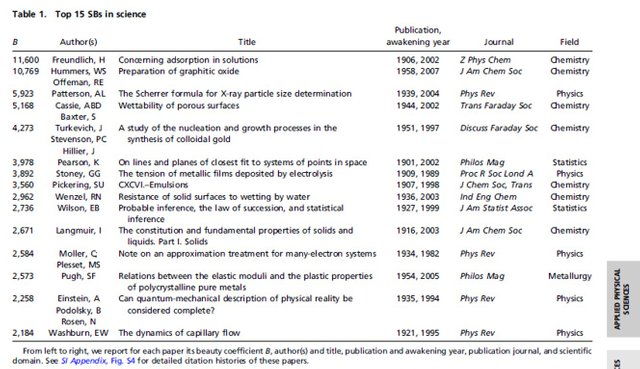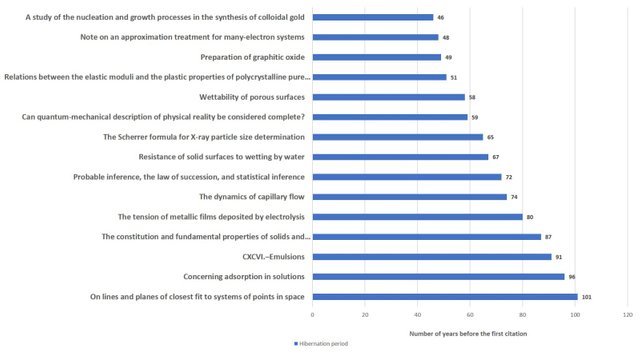Hi steemians! I hope you have not clicked and hoping to see beautiful women in this post. If you are, i am sorry! Anyway, today, i am going to talk about an intriguing topic on sleeping beauties in academia - what are they and what lessons can be learnt from it, even for bloggers.
What is sleeping beauty (SB) in academia?
A sleeping beauty in academia is defined as a journal paper which lies dormant, meaning not having cited at all, and then finally being cited multiple times after many years, which in a case is more than 100 years. In internet world, it is just like someone chanced upon a good quality blog post or article published way past a month and then, decided to spread the post. The post suddenly goes viral - read and shared many times over.
There are researchers investigating this phenomenon. This group of researchers from Center for Complex Networks and Systems Research from Indiana University researched in SB metrics and applied their method on 22 million scientific papers. Over here is some of the summarized results:

From here, it seems that Physics and Chemistry paper were papers with the most potential to hibernate. Reason? I don't know. My gut feel is that Physics and Chemistry are the more fundamental sciences to link to other sciences or applications such as statistics, environmental, ecology, etc.
Below is the screenshot of the top 15 SB paper based on their metrics.

And from the results above, i plotted a bar chart based on their hibernation period.

Now, from the results, trivia question.
Which paper in the world has the longest hibernation period before being cited for the first time?
The answer: Karl Pearson’s paper on “On lines and planes of closest fit to systems of points in space” published in 1901 and cited for the first time in 2002.

Karl Pearson is an English mathematician and biostatistician. This SB paper of his explores the relation between principal component analysis (PCA) and the minimization chi distance. This paper become one of the most applied statistical studies in biology, in particular genome-wide expression studies.
If you are interested, you can retrieve his paper from here.
What are the potential lessons from this?
1. Fundamental research is way too important in science
For people who think that fundamental research waste taxpayers’ money, no no no! I disagree! Just because it has no applications now, it does not mean that it will not find an application in the future. And yes, it can be as far as a century later. And of course to steemit bloggers, just because not many people upvote your content enough, it does not mean that your post is not interesting, you just have not found your audience yet. Continue to post and you will get there.
2. Interdisciplinary research is important for science knowledge and technology advancement
Can never emphasize this enough. Increasingly, we have seen different fields sharing and transferring knowledge which is a really good sign. Because researchers can never know if knowledge from other fields can actually solve and problem in your field. Hence, sometimes, it may be a good idea to cross-read papers in other disciplines. You never know if you may be inspired! And of course, to steemit bloggers, cross-read content from other websites too! If you are blogging in #science or #technology, there are lots of great content at Techcrunch, Livescience or even, Nature. There is also a list of open access journals where you can read many great papers. Read them and find it interesting? Or find a paper fascinating? Share it here and we can discuss! Share your thoughts! Do not agree with what the authors said? Review them here. Open up and discuss!
3. Cite, cite, cite
I must also emphasize this: cite, cite, cite! Research something and want to prove your point? Cite! It will make your piece a more powerful piece and it will also prove that you have done research enough to add weight to your point. It will also help gives credit to the original authors for inspiring your thoughts and starting your interests! And you also made their day in showing that someone appreciates their efforts! Can never look down on citation dynamics!
Last but not least, if you are interesting in reading this phenomenon, you can clink on the following link:-
Defining and identifying Sleeping Beauties in science by Qing Ke, Emilio Ferrara, Filippo Radicchi, and Alessandro Flammini (Open access, of course)
So there's still hope for some of my papers to get citations. They are just future sleeping beauties. :)
Downvoting a post can decrease pending rewards and make it less visible. Common reasons:
Submit
Yes, they are just sleeping, waiting for someone who can appreciate their beauty to wake them up :-)
Downvoting a post can decrease pending rewards and make it less visible. Common reasons:
Submit
Go and now
Downvoting a post can decrease pending rewards and make it less visible. Common reasons:
Submit
Great work often does not get the recognition that it deserves right away from the community. I often wonder how many scientific gems are waiting to be rediscovered by the community and to lead to even greater breakthroughs. Very insightful post!
Followed You
~ Np
Downvoting a post can decrease pending rewards and make it less visible. Common reasons:
Submit
Nice jobs
Downvoting a post can decrease pending rewards and make it less visible. Common reasons:
Submit
Thank you :-) Yes, i am sure there are still a lot of hidden scientific gems around. Hopping to dig them out and the community can read it and be inspired.
Downvoting a post can decrease pending rewards and make it less visible. Common reasons:
Submit
Cool! I don't think I knew this. "Sleeping beauty" sounds vaguely familiar, but I'm not sure...
Yes, fundamental science is very important and is not a waste of money!
Downvoting a post can decrease pending rewards and make it less visible. Common reasons:
Submit
Yes, the first time i read it, i thought it was fairy tale academia story or something. I think they gave quite a good name.
Downvoting a post can decrease pending rewards and make it less visible. Common reasons:
Submit
Various reasons for this interesting phenomena, one that springs to my mind : it could that these papers were overshadowed by latter relevant works from the same authour. Another could be the time between concept ideation and progress in real world applications. Intestellar travels research might be citing basic obscure ideas formulated in this century on space time quantum physics generations down the road :) . Maybe .
Downvoting a post can decrease pending rewards and make it less visible. Common reasons:
Submit
Yes, a researcher must have truly in fact the foresight to do research in very obscure area. Just imagine Karl Pearson’s paper on “On lines and planes of closest fit to systems of points in space” was published in 1901 and cited for the first time in 2002 and he passed away in 1936. He left a timeless legacy and paper.
Downvoting a post can decrease pending rewards and make it less visible. Common reasons:
Submit
There are trends, and many people like to follow hot topics. This brings easy-going citations, conference invitations, ... and also sometimes jobs. However, this does not mean that the science in there is sky-rocketting and that anything that is not part of the hot topics of the moment is pointless. Many very very interesting papers are actually not that much cited and seen, as you say in your post. It is however harder to advertise them (but we can manage).
Downvoting a post can decrease pending rewards and make it less visible. Common reasons:
Submit
Yes, you hit it right on the nail. I am not sure if i can agree with researchers doing research on hot topics, rather than following one's passion, which i think is very important if one wants to work in academia and scientific research.
Yes, it is. harder than blogposts...
Downvoting a post can decrease pending rewards and make it less visible. Common reasons:
Submit
Wow, very interesting post.
It is interesting that interdisciplinary chemistry and physics tend to have the largest amount of sleeping beauties. Like you pointed out, it may be because due to their interdisciplinary quality.
Also, maybe because these disciplines are the most popular so have the largest numbers of scientists contributing to the research, which makes a lot os studies to be missed or forgotten?
But this is just my guess. We would need statistical data for this to verify :-)
Downvoting a post can decrease pending rewards and make it less visible. Common reasons:
Submit
Yea, there is a group of researchers just doing citation dynamics with data and stuff. Very interesting!
Downvoting a post can decrease pending rewards and make it less visible. Common reasons:
Submit
The NIH is even beginning to fund librarians to increase the output of research teams. http://www.ncbi.nlm.nih.gov/pmc/articles/PMC3794685/
Downvoting a post can decrease pending rewards and make it less visible. Common reasons:
Submit
And this Harper's article by Jonathan Lethem veers into science on page 9.
http://harpers.org/archive/2007/02/the-ecstasy-of-influence/
'Artists and intellectuals despondent over the prospects for originality can take heart from a phenomenon identified about twenty years ago by Don Swanson, a library scientist at the University of Chicago. He called it “undiscovered public knowledge.” Swanson showed that standing problems in medical research may be significantly addressed, perhaps even solved, simply by systematically surveying the scientific literature. Left to its own devices, research tends to become more specialized and abstracted from the real-world problems that motivated it and to which it remains relevant. This suggests that such a problem may be tackled effectively not by commissioning more research but by assuming that most or all of the solution can already be found in various scientific journals, waiting to be assembled by someone willing to read across specialties. Swanson himself did this in the case of Raynaud’s syndrome, a disease that causes the fingers of young women to become numb. His finding is especially striking — perhaps even scandalous — because it happened in the ever-expanding biomedical sciences.'
Downvoting a post can decrease pending rewards and make it less visible. Common reasons:
Submit
So true!!! Yes, but but this "someone" will really have a hard time. Imagine he/she need to have a little knowledge here and there to assemble everything. not easy...
Downvoting a post can decrease pending rewards and make it less visible. Common reasons:
Submit
Right, which was why I mentioned the librarians as team members, who would presumably be able to ask their team experts about the things they found trolling the literature. Or maybe the scientist in question just happens to be one of those people who always think in terms of synthesis, which is not really a recognized skill set in academia, but an important one (in my opinion, since that's how I think).
Downvoting a post can decrease pending rewards and make it less visible. Common reasons:
Submit
Very interesting. Indeed, scientists, being scientists, are highly specialised in their fields and may neglect other aspects. And so, getting librarians who are interested in the knowledge nd want to synthesize knowledge can be the one to assemble this.
Downvoting a post can decrease pending rewards and make it less visible. Common reasons:
Submit
As a non-woman sufferer of Raynaud's, I resent the implication that only women are subject to this phenomenon.
Downvoting a post can decrease pending rewards and make it less visible. Common reasons:
Submit
On behalf of Jonathan Lethem -- who wrote the article, and whom I do not know -- sorry, his bad.
Downvoting a post can decrease pending rewards and make it less visible. Common reasons:
Submit
Apparently Dr. Swanson died in 2012, but Wikipedia has a list of his publications in this area of literature-based discovery.
https://en.wikipedia.org/wiki/Don_R._Swanson
Downvoting a post can decrease pending rewards and make it less visible. Common reasons:
Submit
Seems that he is the first to talk about it from the medical research angle.
Downvoting a post can decrease pending rewards and make it less visible. Common reasons:
Submit
You can find beautiful women here lol
Downvoting a post can decrease pending rewards and make it less visible. Common reasons:
Submit
hmmm NSFW here
Downvoting a post can decrease pending rewards and make it less visible. Common reasons:
Submit
Are we spoiled by cute cat videos?
Downvoting a post can decrease pending rewards and make it less visible. Common reasons:
Submit